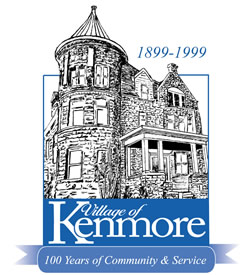
Fun Fact
Did you know that there are no Streets in Kenmore? All of our streets are Roads, Avenues, or Boulevards.
The Village of Kenmore is “Buffalo’s First Suburb”. Following the Civil War, the City of Buffalo’s population grew tremendously. With the invention of electric streetcars, people were able to live outside of walking distance from their jobs. By 1888, L.P.A. Eberhardt purchased land just north of the Buffalo border and began to build a home. Churches were erected beginning in 1891 and the first Village store was opened in 1897.
The first school was erected in 1892. The Kenmore Union School was built where the Municipal Building now stands. The school was utilized until 1911 when the Washington School was opened.
In 1889, the Village boasted a horse-drawn omnibus, which ran up and down Delaware Avenue at no charge to passengers. Lots sold for $250.00 and by 1890 nearly 300 people called Kenmore home. There were no sidewalks, streetlights or sewers. Drinking water was scarce and there were only dirt roads.
Because neither Buffalo nor Tonawanda were willing to fund wood-plank sidewalks, sewers or water, residents wanted to incorporate into their own municipality so that they could raise taxes to provide for the needs of the residents.
By 1899, the Village had enough residents to qualify for legal incorporation. 313 persons signed the proposition calling for incorporation. An election was held, and the Village was incorporated on September 18, 1899.
The Kenmore Municipal Building was constructed in the 1930s at the location of the original Kenmore School. The Building was designed by EB Green as a Works Project (WPA) project during the Depression. The Village owned the land and the Town of Tonawanda was looking for a location for its government offices. Through one of the first Intermunicipal Agreements, the Town of Tonawanda and the Village of Kenmore constructed the building. Both the Village of Kenmore and Town of Tonawanda share building space to this day.
In 1999, the Village marked its Centennial with many community events, including burial of a time capsule in front of the Kenmore Municipal Building. The Quasquintennial was observed on 9/14/24.
The Fire Department was established in 1903 and the Kenmore Police Department was created in 1919.
In 1924, the Kenmore Junior Senior High was built on Delaware Road. This building is the oldest school in the KenTon School District. A major addition, was completed in 1929 to accommodate the increased population in Kenmore. This addition represents nearly 2/3 of the building.
HOW DID THE VILLAGE OF KENMORE GET ITS NAME?
Former Village Historian, Frederick Parkhurst, explained how the Village was named “Kenmore” in his 1925 book, History of Kenmore (archive.org). The book explains that Louis Eberhardt, known as the Father of Kenmore, opposed naming the Village “Eberhardt”. He was responsible for buying up farmland and subdividing the property into a suburban development. The building which is portrayed on the Village logo is of the Eberhardt Mansion, located at the corner of Delaware Avenue and Kenmore Avenue.
There are several places called Kenmore in the United States. “Historic Kenmore” in Virginia, is the home of George Washington’s sister, Elizabeth. There is also a neighborhood located in southwest Akron, Ohio. The City of Kenmore is located in the state of Washington.
In the United States, the name “Kenmore” may have originated from a small island on the south-west coast of Ireland or from a village in Scotland.
The following is an excerpt from Mr. Parkhurst’s book:
It was proposed calling the village “Eberhardt” ; but firmly and modestly Mr. Eberhardt said, “No, they might nickname it ‘Dutchtown’.” But the real reason was Mr. Eberhardt’s aversion to personal publicity and display. The Erie Railroad was building a station at this time in the north-east section of
Buffalo near Main Street and had chosen the name “Kenmore”, but Mr. Eberhardt with an ear for euphony, appropriated the name for the fast growing community and the name “Kensington” was attached to the Erie Station. A sign bearing the name “KENMORE” was placed at the intersection of Delaware and Kenmore Avenues, where all who ran might read.
MANY VILLAGE STREETS HAVE CHANGED NAMES OVER THE YEARS!
- Argonne Dr was called Linden Avenue
- Chapel Rd was called Jefferson Avenue
- Columbia was called Kelso
- Crosby Avenue was called East Wabash
- Delaware Avenue was called West Delaware
- Delaware Road was called East Delaware
- Delwood Rd was called Chautauqua Avenue
- East Girard was called Perrin
- Keller was called Prescott Avenue
- Kenmore Avenue was called East and West Kenmore
- Kenton was called Miller – Sterling
- Kenwood Rd was called Cattaraugus Avenue
- Landers was called Madison Avenue
- Lincoln Blvd was called Walker.
- Mang Avenue was called Cooke
- Nash Rd was called Michigan Avenue
- North End Avenue was called Prospect Avenue
- Palmer was called Paige
- Parkwood was called East Tremaine
- Victoria was called Ullman
- Wardman Rd was called Cornell Avenue
- Washington was called Prairie
- Westgate Rd was called Commonwealth Avenue
